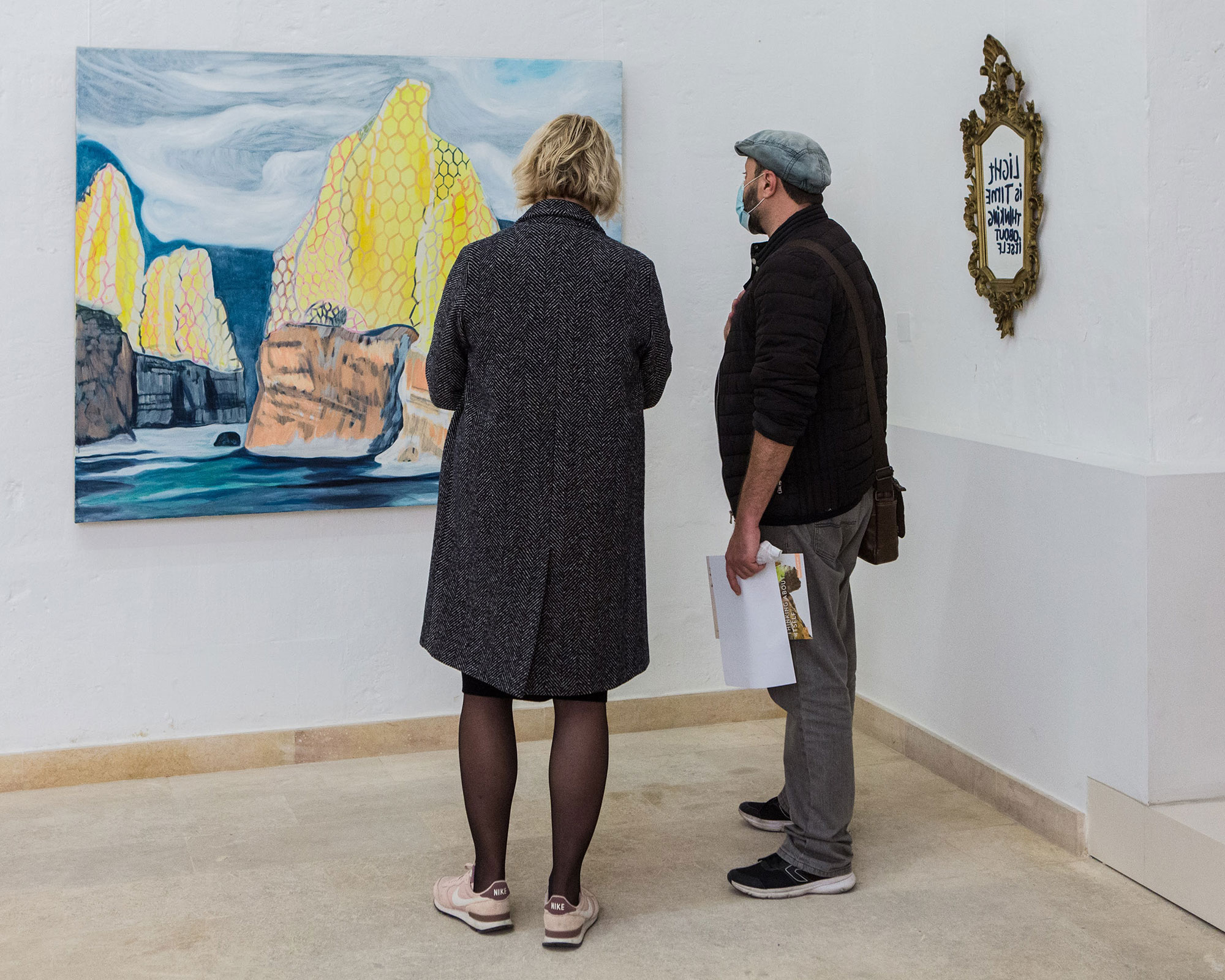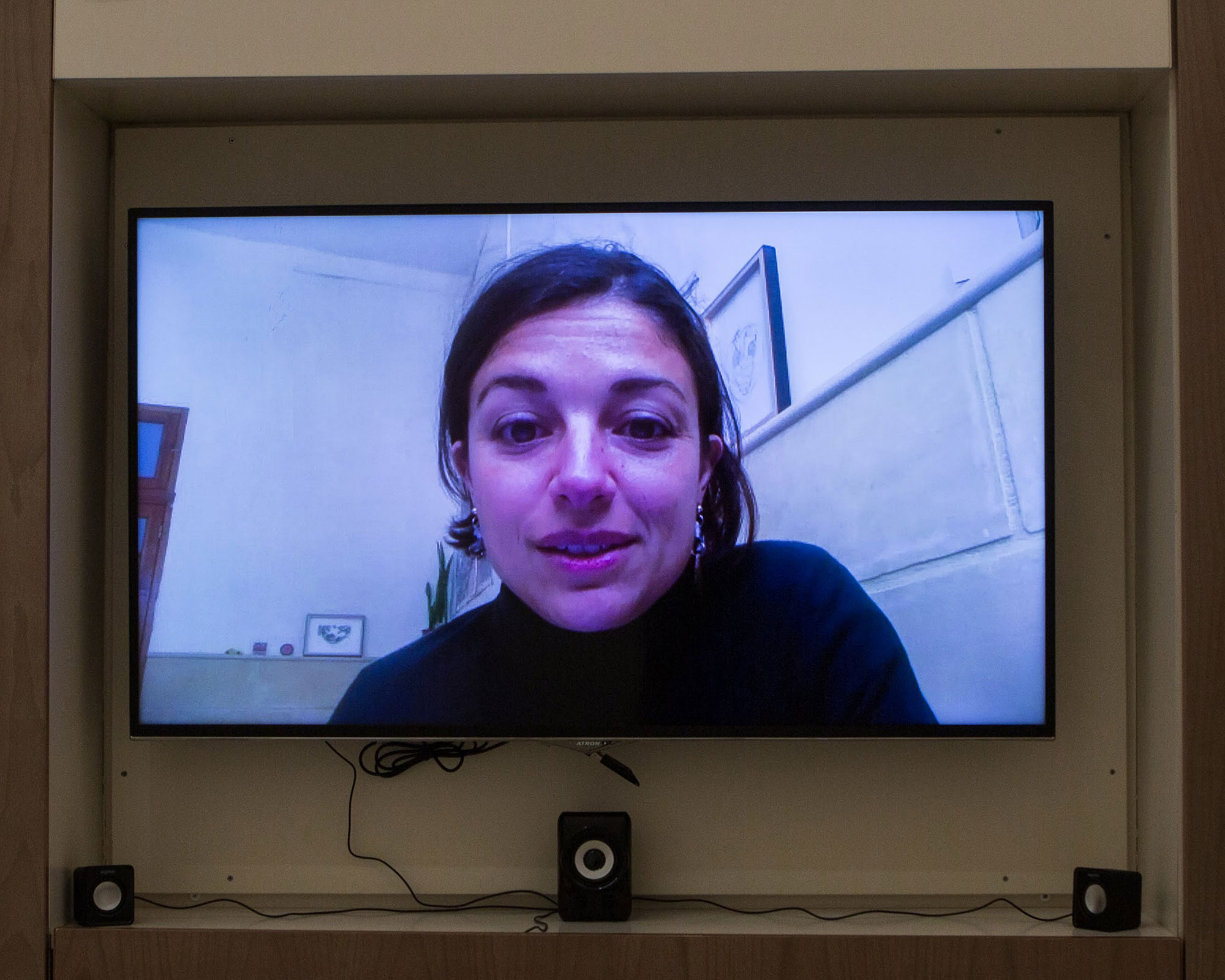 MUZA National Fine Art Museum, Valetta (Malta)
MUZA National Fine Art Museum, Valetta (Malta)5 March – 11 April 2021
Light is Time Thinking About Itself
Solo Exhibition
2021
Solo Exhibition
2021
light escapes through a passage of mirrors
and returns to light:
is a hand that invents itself,
an eye that sees itself in its own inventions.
Light is Time Thinking About Itself.
Quote from Sight and Touch,Poem by Octavio Paz, 1995.
Light is Time Thinking About Itself speaks about landscapes without the presence of humankind. The artist Antje Liemann takes our recent lockdowns – with their home-isolation ad absurdum – as the starting point for imagining a differently calibrated world, looking forward to the possibility of the end of humankind’s domination over the earth. Through interactions with experts and artists, the project asks if there is still time left to rethink our relationship with the world, or if the belief in the sovereignty of humankind has brought us to the brink of collapse of our living conditions.
Through large-scale paintings, objet-trouvé installations and a film documentary, Antje Liemann imagines post-human and post-Anthropocene scenarios – including a Malta colonised by bee-like hybrid beings and once-extinct colossal orchids – and attempts to bring us closer to the reality of the fragility of our existence.
A series of workshops under the guidance of the artist accompanies the exhibition, inviting participants to take this ‘temporary closure of the world’ as a starting point for the creation of objects or paintings. Margerita Pulè
Through large-scale paintings, objet-trouvé installations and a film documentary, Antje Liemann imagines post-human and post-Anthropocene scenarios – including a Malta colonised by bee-like hybrid beings and once-extinct colossal orchids – and attempts to bring us closer to the reality of the fragility of our existence.
A series of workshops under the guidance of the artist accompanies the exhibition, inviting participants to take this ‘temporary closure of the world’ as a starting point for the creation of objects or paintings. Margerita Pulè









Nature without humans. Humans without nature.
Human systems - societies, economies - exist within those of a larger sphere, a biosphere, or what Antje Liemann refers to as nature. Within the life-support systems that nature affords us, we humans can act; with nature we interact; from it - we extract; and, in the process, we impact.
It is obvious of course, that our myriad activities, indeed ourselves would simply not be viable without the favourable conditions that nature presents. We, and all we do, are immensely vulnerable to this sweet spot, this set of natural circumstances that make it just right to survive: just the right temperature, the right amount of water, the right air quality, the right degree of biodiversity…
Yet there is a real risk of such conditions changing sufficiently for this comfort zone to be lost. A risk heightened by irreversible climate change, drought and biodiversity collapse. For some, these threats have already materialised and morphed into relocation or forced migration. And Malta could feel this too, positioned as it is to be vulnerable to sea-level change, shortage of rain and migration flows.
...
Antje’s own contemplation departs from the ordinary in that it is not a scientific mapping or a projection of the various impacts of humans, nor is it an analysis of some policy scenario or other. Rather, Antje starts from the end. Imagine, she asks, if humans were no longer here. What would happen to nature?
The most challenging part of this question, perhaps, lies not in conjuring an image of nature without humans: we have millions of years of pre-history, and history, to assist us in that endeavour. In Malta itself, humans only set foot less than 8,000 years ago; there were only some 20,000 people on the islands until 500 years ago. Evidence of what Malta looked like before this number burgeoned 25-fold is sparse, but not entirely absent. And there are many other territories, close enough to us geographically, from deserts to forests, to allow us to visualise what nature in Malta looks like - without us.
The challenging aspect of the quest Antje presents lies in allowing ourselves to project our own end: the extinction of humankind as a whole or, at any rate, the collapse of civilization as we know it. Such a forecast is not improbable if we proceed with business as usual. Consider the precariousness of the health of the planet itself, the exponential increase in population, the threat of unleashed nuclear weaponry, synthetic biology, pandemics and other emerging crises. Indeed, as nature changes in response to human impact, it becomes more and more plausible to imagine a scenario of nature unfit by, and therefore void of, humans.
As if to lift us out of existential despair, Antje also asks us to visualise harmony between people and nature and to contemplate what could lead to such an outcome. In so doing, she joins the legions of environmental activists, scientists, philosophers, policy-makers and increasingly, politicians, who have sought to promote such a vision of “harmony with nature”, “sustainable development” or even “circular economy”.
Slowly but steadily, over the last five decades, this vision, and the question of how to get there, has made its way from fringe to mainstream. There is now enough science, including social science to answer the question. But what seems to be missing is the capacity, the inspiration, the will to act collectively. It is conceivable that this could galvanise when we are face-to-face with crisis. Antje’s work is ultimately an invitation to think about nature without humans, ahead of a situation where humans are left without nature.
Marie Briguglio
![]()
Curator
Margerita Pulè
Contribution by
Letta Shtohryn
Exhibition Tour online
See the exhibition viewing room here thanks to Artz ID.
Press
Nature without humans, humans without nature, Times of Malta, published 27 August 2021
Light is Time Thinking About Itself, The Malta artpaper, published 24 June 2021
Catalogue
lightistimethinkingaboutitself.pdf
Photos
Elise von Brockdorff
Supported by
Arts Council Malta - Project Support Scheme
Embassy of Germany in Malta, Valletta
Human systems - societies, economies - exist within those of a larger sphere, a biosphere, or what Antje Liemann refers to as nature. Within the life-support systems that nature affords us, we humans can act; with nature we interact; from it - we extract; and, in the process, we impact.
It is obvious of course, that our myriad activities, indeed ourselves would simply not be viable without the favourable conditions that nature presents. We, and all we do, are immensely vulnerable to this sweet spot, this set of natural circumstances that make it just right to survive: just the right temperature, the right amount of water, the right air quality, the right degree of biodiversity…
Yet there is a real risk of such conditions changing sufficiently for this comfort zone to be lost. A risk heightened by irreversible climate change, drought and biodiversity collapse. For some, these threats have already materialised and morphed into relocation or forced migration. And Malta could feel this too, positioned as it is to be vulnerable to sea-level change, shortage of rain and migration flows.
...
Antje’s own contemplation departs from the ordinary in that it is not a scientific mapping or a projection of the various impacts of humans, nor is it an analysis of some policy scenario or other. Rather, Antje starts from the end. Imagine, she asks, if humans were no longer here. What would happen to nature?
The most challenging part of this question, perhaps, lies not in conjuring an image of nature without humans: we have millions of years of pre-history, and history, to assist us in that endeavour. In Malta itself, humans only set foot less than 8,000 years ago; there were only some 20,000 people on the islands until 500 years ago. Evidence of what Malta looked like before this number burgeoned 25-fold is sparse, but not entirely absent. And there are many other territories, close enough to us geographically, from deserts to forests, to allow us to visualise what nature in Malta looks like - without us.
The challenging aspect of the quest Antje presents lies in allowing ourselves to project our own end: the extinction of humankind as a whole or, at any rate, the collapse of civilization as we know it. Such a forecast is not improbable if we proceed with business as usual. Consider the precariousness of the health of the planet itself, the exponential increase in population, the threat of unleashed nuclear weaponry, synthetic biology, pandemics and other emerging crises. Indeed, as nature changes in response to human impact, it becomes more and more plausible to imagine a scenario of nature unfit by, and therefore void of, humans.
As if to lift us out of existential despair, Antje also asks us to visualise harmony between people and nature and to contemplate what could lead to such an outcome. In so doing, she joins the legions of environmental activists, scientists, philosophers, policy-makers and increasingly, politicians, who have sought to promote such a vision of “harmony with nature”, “sustainable development” or even “circular economy”.
Slowly but steadily, over the last five decades, this vision, and the question of how to get there, has made its way from fringe to mainstream. There is now enough science, including social science to answer the question. But what seems to be missing is the capacity, the inspiration, the will to act collectively. It is conceivable that this could galvanise when we are face-to-face with crisis. Antje’s work is ultimately an invitation to think about nature without humans, ahead of a situation where humans are left without nature.
Marie Briguglio

Curator
Margerita Pulè
Contribution by
Letta Shtohryn
Exhibition Tour online
See the exhibition viewing room here thanks to Artz ID.
Press
Nature without humans, humans without nature, Times of Malta, published 27 August 2021
Light is Time Thinking About Itself, The Malta artpaper, published 24 June 2021
Catalogue
lightistimethinkingaboutitself.pdf
Photos
Elise von Brockdorff
Supported by
Arts Council Malta - Project Support Scheme
Embassy of Germany in Malta, Valletta
©2023 Antje Liemann. All Rights Reserved.